Display Battery Percentage on Your iPhone: A Complete Guide
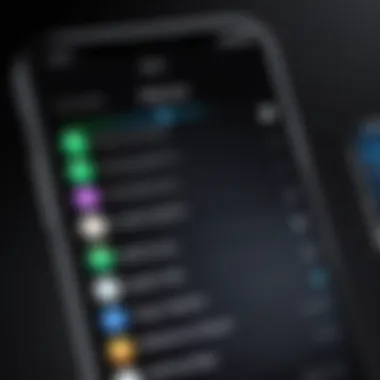
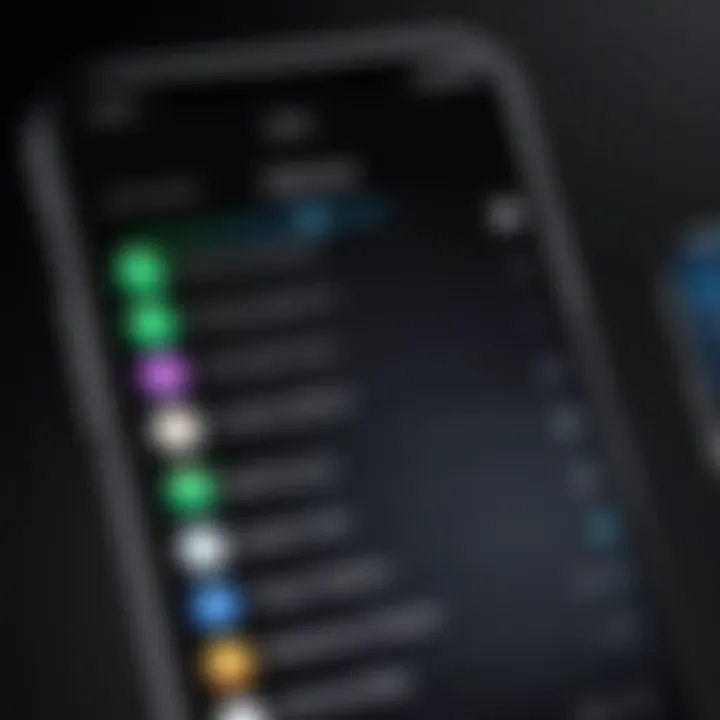
Intro
In our increasingly digital world, monitoring device metrics like battery life is crucial for a seamless user experience. For iPhone users, knowing the exact battery percentage can save time and frustration. This article explores various methods to display battery percentage on different iPhone models. We will discuss the steps that vary depending on whether you have an older or a more recent device. In addition to that, we'll also point out common issues users encounter. This guide aims to educate readers and enhance their understanding of iPhone settings to optimize daily usage.
Overview of the Technology
The battery life of an iPhone is central to the device's performance. Each new iteration of iPhones comes with improvements not only in hardware but also in software efficiency, affecting battery longevity. Understanding how to access battery percentage is an essential skill for any user.
Key Specifications
Modern iPhones feature lithium-ion batteries that are designed to maximize performance. The operating system, iOS, provides users with insights into their battery usage. For models like iPhone 11 and above, Apple's efficiency technologies extend battery life, allowing for longer periods of use without charging.
Unique Selling Points
Displaying battery percentage is not just about convenience; it reflects Apple's user-centric design philosophy. Knowing how much charge remains enables informed decisions such as when to charge the device or when to close background apps. This small change can significantly improve your daily iPhone usage.
Why Is Battery Percentage Important?
Understanding your battery percentage rather than just relying on a battery icon can lead to better device management. Users can track how apps consume power and adjust their usage accordingly.
"A proactive approach to battery management enhances your iPhone experience, preventing unwelcome surprises."
How to Enable Battery Percentage on Different iPhone Models
For iPhone and Later
- Open the Settings app.
- Scroll down and tap on Battery.
- Toggle the Battery Percentage switch to the ON position.
For iPhone and Earlier
- Access the Settings app.
- Navigate to Battery settings.
- Enable the Battery Percentage toggle.
By following these simple steps, users can always stay informed about their iPhone’s battery status.
Common Issues and Troubleshooting
Despite being a straightforward process, some users may experience difficulties. If your iPhone does not show the battery percentage after enabling it:
- Restart your device.
- Ensure your iOS is up to date.
- Check if there are any restrictions set in your device settings.
If problems persist, consider reaching out to Apple support.
End
Displaying battery percentage on your iPhone is a simple yet effective function that enhances user experience. Whether you use an older model or the latest iPhone, being aware of your battery life can lead to more efficient device management. Following the outlined steps, you can easily enable this feature and troubleshoot any issues that may arise. By optimizing how you use your device, you contribute to a smoother, more enjoyable technology experience.
Understanding Battery Percentage Importance
Knowing the battery percentage on an iPhone is more than just a trivial detail; it plays a crucial role in user experience and device management. The primary reason for displaying battery percentage is to provide users with a transparent view of their device's power status. This insight helps in making informed decisions regarding device usage, charging habits, and battery preservation.
Devising a strategy around battery percentage can notably enhance the efficiency of device utilization. For instance, users can better plan to charge their iPhones by recognizing when the battery is running low. It leads to a seamless experience, avoiding those frustrating moments when the phone unexpectedly dies. Furthermore, understanding battery percentage allows users to gauge the longevity of their devices—enabling them to adapt their behavior based on actual usage patterns rather than assumptions.
"Battery percentage is not just a number; it is an essential metric that influences user behavior and device management."
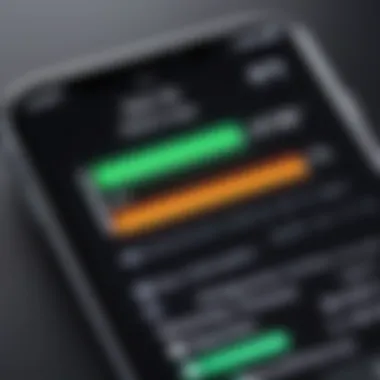
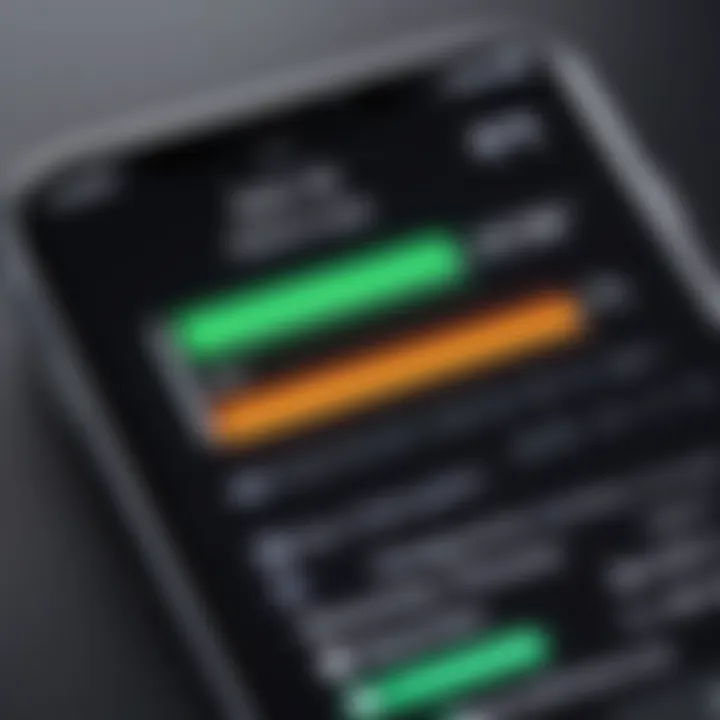
The benefits extend beyond just knowing the current charge level. By actively monitoring battery percentage, users can engage in effective battery management. It may involve avoiding situations where the battery dips under a certain threshold or ensuring that the app usage does not drain the battery too quickly. Having the battery percentage easily visible serves as a cue to users, prompting them to adjust their interactions with the device as required.
Additionally, reliable battery indicators contribute to stress reduction. Knowing exactly how much battery remains can alleviate battery anxiety—a common concern among heavy users who depend heavily on their devices for communication and work. It fosters a sense of control over how you utilize your iPhone throughout the day.
In summary, understanding battery percentage importance lays the foundation for better device management. Whether it is about charging decisions, daily usage adjustments, or simply minimizing anxiety regarding battery life, the ability to see the battery percentage clearly empowers users. This article will provide comprehensive guidance on displaying battery percentage on different iPhone models, allowing readers to harness the benefits of this essential feature.
Current iPhone Models Overview
The landscape of iPhone models is a dynamic one, reflecting not only the evolution of technology but also user needs. Understanding which model you possess is crucial when discussing how to display the battery percentage. Each iPhone generation brings nuances in settings and features that may affect the process of enabling this essential display option.
Both older and current devices handle battery percentage differently, and this section elucidates those differences. This awareness allows users to maximize the functionality of their devices while maintaining optimal battery management. Additionally, comprehending the variation across models can help identify which devices may need more frequent monitoring of battery life due to their older technology.
Older Devices: iPhone and Below
Older iPhone models, including the iPhone 8 and below, incorporate a more traditional approach to displaying battery status. Users of these devices access battery percentage through a straightforward journey within the Settings menu.
Once you enter Settings, navigate to the Battery section. Under this category, you will find the option to enable battery percentage. This process is quick and is applicable to all devices in this range. Additionally, these models feature distinct battery icons, which may not display percentage without specific activation. The clarity of battery life is pivotal for users who rely on their devices for day-to-day functions, making this knowledge even more significant.
Current Models: iPhone and Above
Starting with the iPhone X, Apple shifted to a design without a physical home button, introducing new ways to present battery information. In these models, the battery icon remains a vital indicator located on the upper right of the screen. However, displaying battery percentage requires additional steps that are slightly different from older devices.
For iPhone X and later, users can access the Settings app, select the Battery option, and activate battery percentage display. The significant change in design also brings about alternative methods to check battery life, such as using the Control Center or widgets, which enhances user experience.
This adjustment serves an important function in user interaction, making battery status easily accessible amidst the other functionalities that an iPhone offers. Knowing how to efficiently navigate these settings is vital for users who prioritize battery management, particularly during prolonged device usage.
Enable Battery Percentage in Settings
Having the battery percentage visible on an iPhone is not just a convenience; it is essential for effective device management. In a world where smartphones are our primary tools for communication and work, knowing the exact battery level helps users plan usage accordingly. This section will guide you through enabling the battery percentage on your iPhone, ensuring you always have this important information at your fingertips.
Accessing Settings Menu
To begin, unlock your iPhone and look for the "Settings" app. It is usually represented with a gear icon on your home screen. Tap on this icon to enter the settings area. Navigating through the settings provides access to numerous features that allow users to customize the iPhone experience. From here, you can manage everything from notifications to privacy settings, making it a vital step in battery management.
Locating the Battery Option
Once you are in the settings menu, scroll down until you see the option labeled "Battery". Tap on it to explore the battery-related features your device provides. This section provides insights about your battery usage. Knowing how your battery performs for different applications can help in understanding why the battery may drain faster at times. Here, you will also find different options that inform users about battery health and charging needs.
Activating Battery Percentage Display
Now, within the Battery settings, locate the toggle for "Battery Percentage." Simply switch this to the "on" position. Upon activation, a percentage figure will appear in the upper right corner of your screen, next to the battery icon. This small adjustment may seem trivial, but it significantly enhances your ability to manage battery life effectively. Making this change can reduce battery anxiety and provide clarity regarding how much power is left at any given moment. Always keeping this number in mind allows users to make informed decisions about charging and usage, maximizing daily performance.
Enabling the battery percentage display is an incremental yet powerful step in maintaining control over your iPhone's battery health.
Alternative Method for Older Models
In the context of this article, exploring the Alternative Method for Older Models is essential. This section helps users who own devices like the iPhone 8 and earlier. These older iPhones do not have the same options in settings as newer models. Hence, knowing effective ways to display battery percentage can improve everyday usage. By frequently checking battery status, users can manage their device better, avoiding unexpected shutdowns during critical moments.
Utilizing Control Center
On older iPhone models, accessing battery percentage can be done easily through the Control Center. To do this, follow these steps:
- Swipe up from the bottom of the screen. This action opens the Control Center, providing quick access to various functions.
- Look for the battery icon located on the right side of the Control Center. The percentage may appear next to the icon, indicating the remaining battery life.
- If the percentage does not show, touch and hold the battery icon until the battery percentage becomes visible.
Utilizing Control Center is not only simple but also efficient. That makes it a reliable method for users who often need a quick check on battery life without diving deeply into settings.
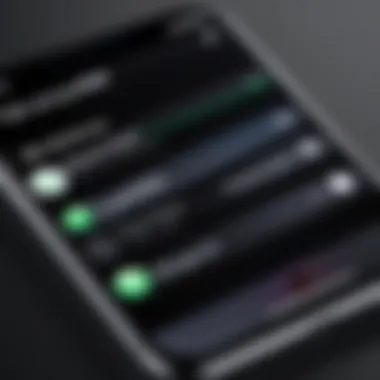
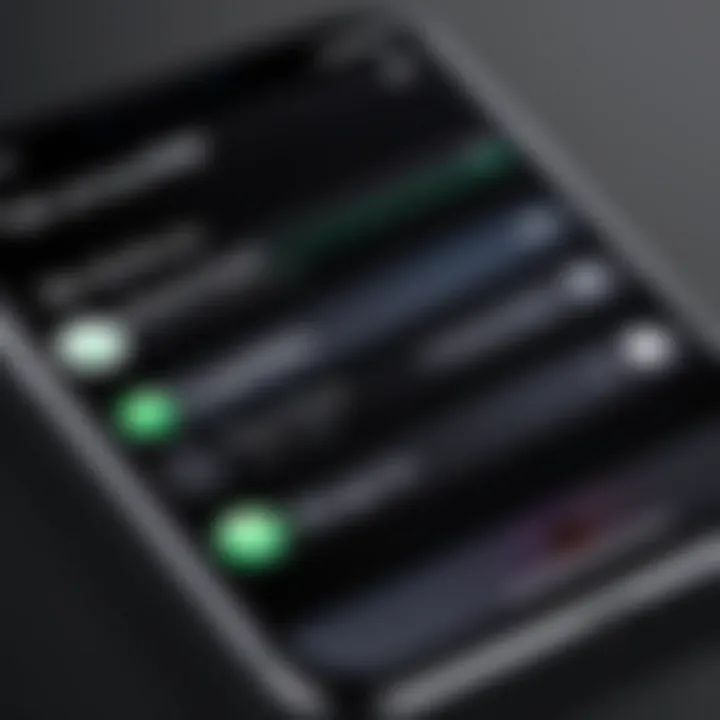
Reading Battery Percentage without Settings
Various ways exist to find the battery percentage even without navigating through the settings menu. One of these methods is monitoring the battery icon itself on the status bar.
- When the battery charge drops significantly, the icon changes in appearance. This visual indicator hints at the need for a charger.
- Additionally, if the iPhone is connected to a charger, the battery icon may show a lightning bolt, confirming that it is charging. This can be an indirect way to gauge battery status when users don’t have the percentage displayed.
Overall, these methods highlight how users of older iPhones can stay informed about their battery status without complex procedures. This knowledge enables users to maintain efficient device performance and avoid battery-related issues.
Common Issues with Battery Percentage Display
Understanding the common issues associated with the battery percentage display on iPhones is vital for optimizing device use and user experience. Troubles with the battery display not only causes confusion but can also lead to unreliable power management. Users rely on accurate battery percentage indicators for planning their activities throughout the day. When the display fails to show the correct percentage or does not appear at all, it can lead to unnecessary anxiety regarding the device's battery life. Moreover, addressing possible errors and glitches insures that users can effectively monitor their battery usage, thus prolonging device longevity.
Troubleshooting Display Errors
Display errors can manifest in various ways. Sometimes, the battery percentage might not appear despite settings being adjusted correctly. Here are some steps to troubleshoot this issue:
- Restart Your iPhone: A simple restart can often resolve glitches. Press and hold the side button and either volume button until the power off slider appears. Slide to power off, then turn it back on.
- Check for Updates: Ensure that the iOS is running the latest version. New updates may include fixes for previous bugs. Go to Settings > General > Software Update to check.
- Reset All Settings: If issues persist, consider resetting all settings. This will not erase your data but will return settings to defaults. Navigate to Settings > General > Reset > Reset All Settings.
- Inspect the Battery Health: A degraded battery health can also result in erratic display behavior. Check battery health under Settings > Battery > Battery Health. If the maximum capacity is notably lower than expected, a battery replacement may be necessary.
- Contact Apple Support: If all else fails, contacting support might be the best solution. They can provide insights into more complex issues that might not resolve through user troubleshooting.
Understanding Software Glitches
Software glitches are an often overlooked aspect when it comes to battery percentage display issues. These glitches can arise from multiple sources including updates, incompatible apps, or bugs in the operating system. Recognizing these glitches is crucial for effective battery management. Here are some common glitches:
- Inaccurate Reporting: Sometimes the battery percentage shown is not aligned with actual battery usage. Users may find their devices dying unexpectedly, contrary to what the display indicates.
- Delayed Updates: The battery percentage may not update in real time. Users might notice a lag or a sudden drop without visual representation.
- Settings Reset: Occasionally, installations can mess with settings inadvertently. Users find that settings like battery percentage need to be reactivated or adjusted after a software installation or update.
When faced with these glitches, users should maintain awareness of their apps. Some third-party applications might interfere with core functions. Always ensure that any app in use is compatible with the current iOS version.
"Regularly updating your iPhone can stave off many of these issues, keeping your experience smooth and reliable."
By being proactive in addressing these concerns, users will not only enhance their experience but also increase productivity. The ability to trust the battery display allows users to better plan their day and avoid unnecessary interruptions.
Battery Widget Feature Prologue
The battery widget has become an essential tool for iPhone users. It gives quick access to battery levels not just for your iPhone, but also for connected devices like AirPods and Apple Watch. This transparent view allows users to monitor battery usage over time, making it much easier to manage device charging schedules.
Understanding the battery widget's functionalities can enhance how you use your iPhone. With just a glance, you can know how much battery life is left, which helps in planning your daily activities. Furthermore, this feature offers customizable options, adapting to different user preferences and enhancing the overall experience.
Adding Battery Widget to Home Screen
To add the battery widget to your home screen, follow these steps:
- Long Press on Home Screen: Begin by pressing and holding an empty area on your home screen until the app icons start jiggling.
- Tap on the Plus Icon: In the top left corner, you will see a '+' icon. Tap on it to open the widget gallery.
- Search for Battery Widget: Scroll or use the search bar to find the "Batteries" widget. This will display available widget sizes.
- Select a Size: Choose a size that fits your layout preferences. You can opt for small, medium, or large, based on how much information you want to see.
- Add Widget to Home Screen: After selecting the size, tap on "Add Widget". It will appear on your home screen.
- Position the Widget: You can drag the widget to your desired location and tap "Done" in the top right corner to finalize your layout.
By following these steps, you will have easy access to your battery information right on your home screen. This feature enhances quick monitoring without the need to explore the settings.
Leveraging Widget for Battery Insights
After adding the battery widget, it is vital to leverage it for better battery management. The widget provides real-time data on battery levels, which assists in tracking how long your iPhone and connected devices last.
Here are some insights you can gain from using the battery widget:
- Live Battery Levels: Monitor current battery percentages for your iPhone and any connected devices.
- Usage Patterns: Observe how your usage affects battery life. If you notice frequent drops, it may signal apps draining power, prompting a review of app settings.
- Connection Awareness: Knowing the battery status of your connected devices, such as AirPods or Apple Watch, can prevent unexpected disconnections during use.
Additionally, seeing your battery level at a glance can help mitigate battery anxiety. It enables better planning during busy days, informing your decisions on when to recharge.
By adopting the battery widget feature, you empower yourself to maintain control over your devices, ensuring you remain connected and productive without the common worry of low battery alerts.
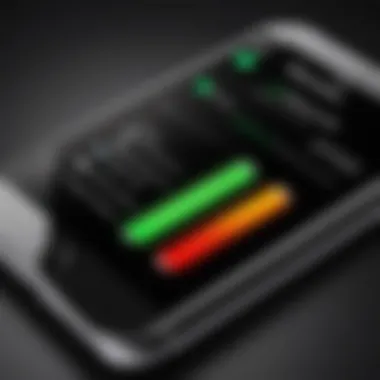
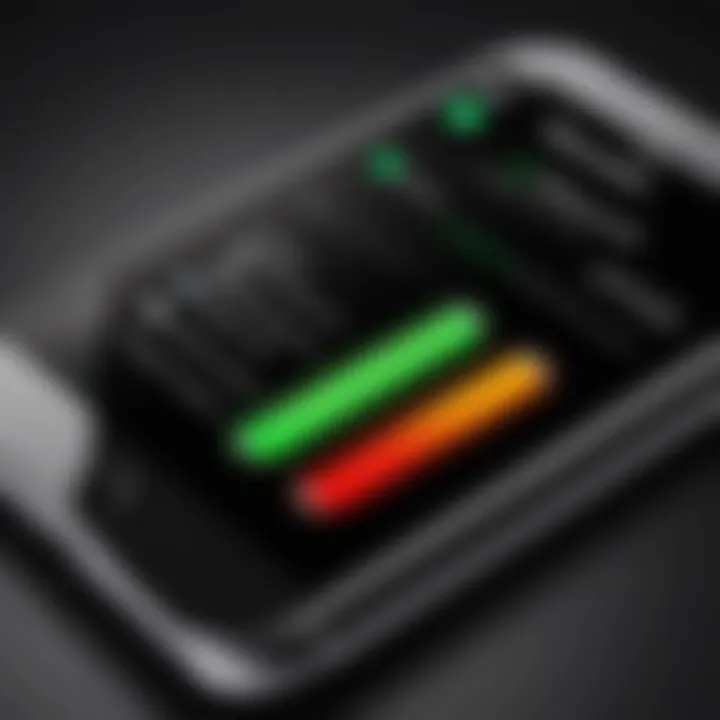
Impact of Battery Display on Usage Patterns
Understanding how the battery display influences user behavior is crucial to the overall experience of iPhone users. Knowing the exact battery level can lead to more informed choices regarding device usage. It allows individuals to manage their time and expectations effectively, especially in situations where battery life can be a deciding factor.
User Behavior Changes with Battery Percentage
When users have access to battery percentage, their approach to device usage typically shifts. The awareness that is instilled by continuous visibility of battery levels can lead to a conscious decision-making process regarding when to charge the device.
- Proactive Charging: Users become more proactive about recharging, leading to less unexpected shutdowns.
- Usage Patterns: Individuals often adjust how they utilize data-intensive apps, knowing that heavy usage drains battery faster.
- Schedule Management: Many choose to limit high consumption tasks during low battery periods to preserve essential functionality until they can recharge.
Potential Reduction in Battery Anxiety
Battery anxiety refers to the stress users feel when they are unaware of their device's power status. The introduction of a battery percentage display can greatly alleviate this concern. When users clearly see their battery levels, it significantly enhances their comfort with the device.
- Calm Usage: Being able to monitor battery life can minimize the frantic search for chargers during crucial moments.
- Improved Planning: Users find reassurance in knowing they have enough power to complete tasks before their next charge, thus allowing for better planning of daily activities.
- Reduced Interruptions: Frequent awareness of battery status can lead to fewer unexpected device lockouts, improving overall user satisfaction.
Continuous awareness of battery levels enables users to make smarter decisions, thus reducing both stress and interruptions.
When Battery Percentage Becomes Crucial
The visibility of battery percentage is not merely a matter of aesthetic preference. Understanding when the battery percentage is displayed can significantly influence device usage. Consumers today rely heavily on their devices for productivity and connectivity. Therefore, knowing how much battery life remains serves a practical purpose. An accurate reading helps avoid unpleasant surprises, like an abrupt shutoff or missed opportunities due to a dead phone.
Identifying Low Battery Alerts
Low battery alerts are essential notifications that alert users to the diminishing power of their devices. When a user enables battery percentage, they can monitor the exact charge level left. This precision allows for proactive measures, such as seeking a charging source or modifying usage habits. Unlike vague alerts that only indicate when the battery is critically low, seeing the specific percentage offers clarity. For example, if the battery reads 20%, a user might decide to change their behavior by reducing app usage or activating Low Power Mode. This proactive approach makes managing battery life more strategic.
Planning for Diverse Usage Situations
Real-life scenarios often dictate how battery life is managed. A user may experience long commutes and rely on navigation apps, or they might engage in tasks that demand significant processing power, such as gaming or video streaming. Each situation can drain the battery at different rates. Planning becomes crucial in such contexts. By knowing the remaining battery percentage, users can tailor their activities to match the available charge.
Consider the following points when planning usage based on battery percentage:
- Assess Activity Levels: Understand how battery-intensive tasks affect longevity.
- Set Realistic Expectations: Not all activities will have the same power consumption, so gauge when to expect a drop in battery level.
- Adapt Accordingly: Change device settings or limit background apps to extend battery life
Having visibility into battery status allows users to make informed decisions, balancing their need for connectivity with the practicality of battery constraints.
The Future of Battery Management on iPhones
The future of battery management on iPhones is an essential consideration for both users and developers. As smartphones become increasingly integral to our daily lives, efficient battery management should be a priority. Users expect devices to blend performance with longevity. This section evaluates anticipated developments and innovative technologies that aim to enhance how we track and manage battery life on iPhones.
Anticipated Software Updates
Future software updates for iOS are likely to introduce new features aimed at improving battery life and management tools. Apple consistently prioritizes user experience and device efficiency. One notable direction could be the integration of smarter algorithms that predict user habits, allowing the device to optimize battery usage based on individualized patterns.
Additionally, there may be enhancements in the battery settings, providing users with more detailed insights. Features such as personalized usage reports could become standard, helping users to understand their battery life better. These updates can reduce the likelihood of unexpected battery drain, thus fostering a sense of reliability in device usage.
Expected Features Include:
- Improved Battery Health Monitoring: Users may receive clearer notifications about battery health and optimal charging practices.
- Adaptive Charging Modes: Updates might enable adaptive charging that adjusts based on usage patterns, helping preserve battery longevity.
- User-Centric Notifications: Users could start receiving notifications tailored to their activities, assisting them in managing their power usage more effectively.
Emerging Technologies for Battery Tracking
Emerging technologies are set to reshape the landscape of battery tracking on iPhones. As the demand for accurate battery management grows, methods to enhance tracking capabilities will evolve. One area of interest is the application of artificial intelligence. AI can analyze vast amounts of usage data to forecast battery performance more accurately.
In addition to AI, the utilization of advanced sensors and battery technology is gaining attention. These might provide real-time data about battery capacity and charging cycles. As these technologies develop, users can expect more intuitive interfaces. These would display not just current battery levels but also predictive analytics on how much longer their devices can perform based on usage trends.
Emerging technologies may also pave the way for longer-lasting battery materials, like solid-state batteries which potentially offer higher capacity and faster charging times compared to traditional lithium-ion.
Effective battery management is not just about monitoring; it’s about enhancing user experience and reducing anxiety regarding battery usage.
Overall, as the iPhone evolves, the integration of these future-oriented solutions will likely lead to a more intuitive, reliable, and transparent battery experience for users.





